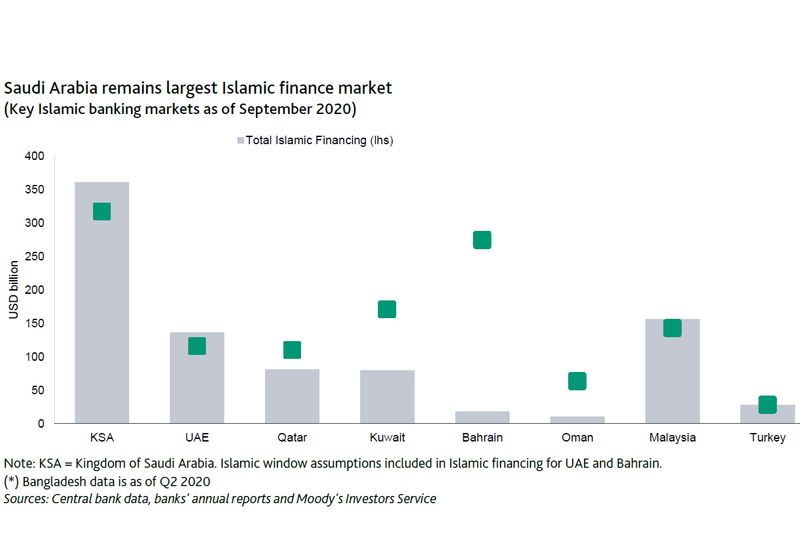
Islamic financing growth to outpace conventional lending in GCC, core Islamic markets in 2021
Bank mergers and consumer demand support Islamic financing assets growth in GCC, Babu Das Augustine, Business Editor
Dubai: Despite difficult operating conditions in most countries amid pandemic-driven economic downturns, demand for Islamic financing assets (lending) across the core Islamic markets will grow in 2021, according to rating Moody’s.
The rating agency said while the Islamic financing remained resilient in 2020 and it expects growth to continue into 2021. In the GCC mergers between Islamic and conventional banks, where surviving entities are Islamic banks, will drive further one-off increases in assets, as they did in 2019 and 2020.
Demand driven growth
Growth in Islamic financing assets remained steady in 2020, despite a marked slowdown in economic activity across core Islamic banking markets (which include the GCC, Malaysia, Indonesia and Turkey), and continued to outpace conventional asset growth. As a result, the market share of Islamic financing assets in core Islamic markets increased to 32.8 per cent of total financial assets (including conventional bank loans) in September 2020, from 31.4 per cent in December 2019 and 30.4 per cent in
Islamic finance penetration in the GCC accelerated in the past decade to reach 45.7 per cent in September 2020 from 32 per cent in 2009. Saudi Arabia was the main contributor to this growth, although similar trends prevailed in the other GCC countries as well. Similarly, the industry has flourished over the years in Malaysia, making its Islamic finance industry the second largest globally.
“Overall, the core Islamic finance markets benefited from increased demand from consumers, which powered strong financing growth of around 8.1 per cent in compound annual terms in the last three years, compared with a 6.2 per cent increase in conventional bank financing,” said Ashraf Madani, VP-Senior Analyst at Moody’s.

M &A a major catalyst
In addition to customer demand, Moody’s said, proactive government legislation and mergers and acquisitions (M&A) have driven growth in Islamic banking assets. In the GCC, there has been a flurry of acquisitions and consolidations in the past few years and the trend accelerated in 2020 amid lower oil prices and deteriorating economic conditions.
In several cases, Islamic banks are acquiring conventional banks and emerging as the surviving entity, substantially adding to their asset bases. All M&A transactions in the GCC in 2020 involved at least one Shariah-compliant bank.
In Saudi Arabia, the merger between National Commercial Bank and Samba announced inOctober 2020 will reinforce National Commercial Bank’s position as the largest bank in the country with an estimated market share of 31 per cent of assets and 30 per cent of deposits (as of Q2 2020). It will also create the world’s largest Shariah-compliant bank along with AlRajhi and Kuwait Finance House.
In Qatar, the announced merger between Al Khalij Commercial Bank PQSC and Masraf Al Rayan QPSC (A1 stable, baa2) will make the resulting entity the fourth largest Islamic finance institution in the region. In Kuwait, the merger between Kuwait Finance House and Bahrain-based Ahli United Bank, once completed, is likely to create the world’s second largest Islamic bank.
Other mergers in 2020 include: the acquisition of Noor Bank by Dubai Islamic Bank in January 2020 with $75 billion in combined assets, the stake increase of Bahrain’s National Bank of Bahrain in Bahrain Islamic Bank in January 2020 with $11.7 billion in combined assets, and an $8.2 billion merger between Oman Arab Bank and Alizz Islamic Bank finalised in July 2020.
UAE among largest markets
Saudi Arabia, Malaysia and the UAE remain the largest markets for Islamic finance globally. Overall, Saudi Arabia remains the largest market for Islamic finance globally, with financing assets rising to $361 billion as of September 2020 from $323 billion in December 2019.
Despite the pandemic-induced economic recession and drop in oil prices, Islamic financing continues to expand in Saudi Arabia, propelled by growing demand from corporate and retail clients for Shariah-compliant products and a supportive regulatory environment with coordination between the Ministry of Finance, Saudi Arabia Monetary Authority (SAMA) and the Capital Market Authority.
“We expect Islamic assets in Saudi Arabia to account for 80 per cent of systemwide loans (including both conventional and Islamic financing assets) over the next 12-18 months, from 78 per cent in 2019,” said Madani.
Despite the continent’s large Muslim population, Islamic banking assets only represent a small portion of Africa’s total banking assets. Moody’s expects Islamic banking to expand significantly in the next five to ten years given the vast financial need of the continent, underpinned by strong demographic and economic growth in Muslim-majority countries, a low starting base and growing government interest in the sector.




